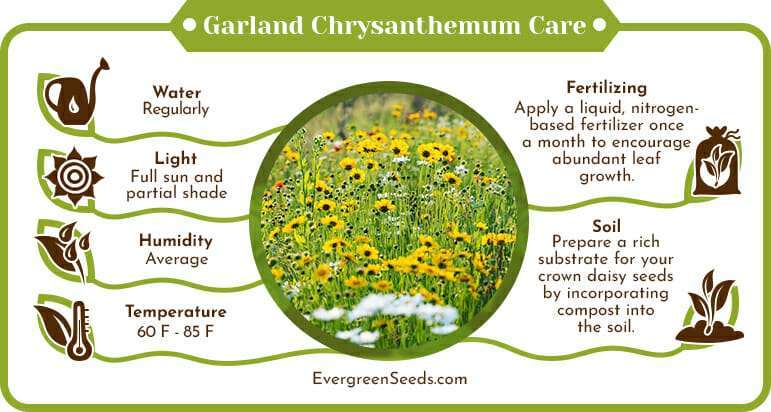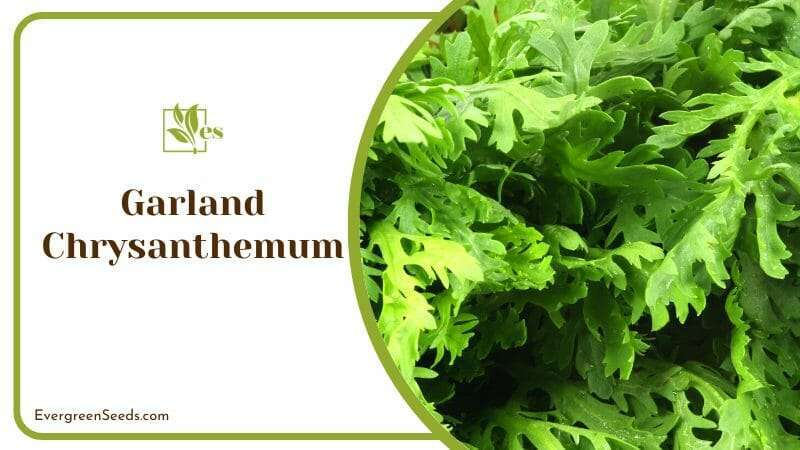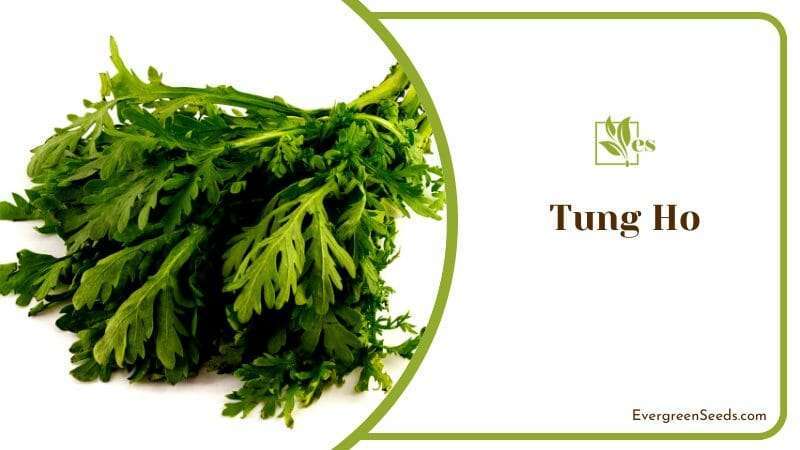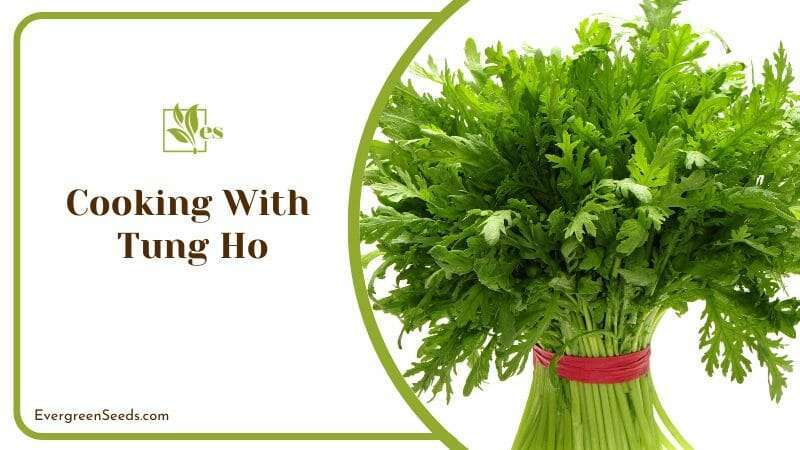- When to Plant Corn in San Diego: Optimal Seasons and Tips - July 19, 2024
- When to Plant Hydrangeas in Illinois: Best Timing for Optimal Growth - July 19, 2024
- Why Are My Radishes Growing Above Ground: Uncovering the Causes - July 19, 2024
 Edible garland chrysanthemum of the Asteraceae family, also called Shingiku (春菊) in Japan, Tung Ho in Cantonese and Choy Suy Green in old Chinatown, is an annual leafy plant from the daisy family.
Edible garland chrysanthemum of the Asteraceae family, also called Shingiku (春菊) in Japan, Tung Ho in Cantonese and Choy Suy Green in old Chinatown, is an annual leafy plant from the daisy family.
Healthy and delicious, it’s among the easiest Asian vegetables of the Glebionis genus to grow at home.
In this guide, we’ll show you how, while providing some pointers for cooking with it.
JUMP TO TOPIC
What is garland chrysanthemum?
Previously known as Chrysanthemum coronarium, garland chrysanthemum’s current Latin name is Glebionis coronaria. It is native to the Mediterranean region but has naturalized in many parts of eastern Asia.
 Nowadays, it is a typical ingredient in Chinese and Japanese cooking. You will find it under several common English names, such as crown daisy, edible chrysanthemum, or chop suey greens.
Nowadays, it is a typical ingredient in Chinese and Japanese cooking. You will find it under several common English names, such as crown daisy, edible chrysanthemum, or chop suey greens.
Garland daisy looks very similar to other varieties of chrysanthemum and produces yellow, showy flowers displayed in a single row.
It can grow as tall as 3 feet (90 cm), although it rarely reaches that height when grown in gardens. Usually, the leaves and stems are picked when the plant is young, no taller than 12 inches (30 cm).
There are two varieties of garland chrysanthemum that you can find on the market:
- A thick, broader leaf variety, with leaves that resemble those of the large chrysanthemum plants;
- A small, tender leaf variety, which looks a bit more similar to parsley;
Both types of Tung Ho are very similar in taste, and they also require the same growing conditions. What sets them apart is the leaves’ texture, with the wider variety being meatier, while the small type is a bit more tender.
How to grow garland chrysanthemum
Garland chrysanthemum is a cold-season crop that is also very beginner-friendly. Whether you’re a seasoned gardener or just getting into growing your vegetables, here’s what you need to know.
1. Growing garland chrysanthemum outdoors
Garland chrysanthemum seeds are tiny and easy to sow. As a result, you can plant them outside directly without germinating them indoors in advance.
 Soil
Soil
Prepare a rich substrate for your crown daisy seeds by incorporating compost into the soil. Make sure to remove any stones and debris, and use soil amendments to provide proper drainage. This plant is very forgiving for the soil type it’s growing in and can tolerate a pH ranging from 5.3 to 7.3. It’s also not picky when it comes to light and can be grown in full sun and partial shade.
 Temperature
Temperature
The best time to grow garland chrysanthemum is in early spring or early autumn. Its ideal temperature range is between 60 °F and 70 °F (16 °C to 21 °C). Although it can tolerate temperatures as high as 85 °F (30 °C), planting crown daisy in hot weather can cause it to bolt. Once the plant starts flowering, its texture and taste change drastically, becoming fibrous, bitter, and not very tasty.
– Spacing
Sow your seeds around 6 inches (15 cm) apart, and water them thoroughly. You should see the first garland chrysanthemum seedlings make an appearance after 7 days or so. This is a fast-growing plant and can reach a height of 8 inches (20 cm) in as little as one month after the seeds have germinated.
 Water and fertilizer
Water and fertilizer
Water your crown daisy plants regularly, as they do not tolerate drought. If you have nutrient-poor soil in your garden, apply a liquid, nitrogen-based fertilizer once a month to encourage abundant leaf growth.
– Maintenance
If you time your sowing schedule right, you can enjoy two crops of crown daisy each year: one in spring and one in autumn. You can try to squeeze a third crop in during summer, although our recommendation is to grow garland chrysanthemum indoors, in pots or containers, or a part of your garden that is a bit more shaded. This way, you will prevent the plants from bolting, producing flowers and seeds before they have enough leaves for harvesting.
Garland chrysanthemum has no pests or diseases. You can even grow it as a companion crop along with marigolds and bunching onions, for example, to protect your other vegetables from caterpillars, aphids, or spider mites. However, garland daisy can quickly be overrun by weeds when young or munched on by slugs and snails.
We don’t recommend using insecticides or herbicides in your garden, so the best way to protect your garland chrysanthemum plant is by hand. Manually weed the seedling beds, taking care not to damage the fragile roots of the chrysanthemum. For slugs and snails, pick them by hand and throw them in a bucket of soapy water before discarding them in the garbage.
2. When to harvest Tung Ho
Garland chrysanthemum can be harvested as early as 30 days after germinating, although sometimes you may need to wait up to 7 weeks for the plant to reach maturity. The best way to harvest Tung Ho is using the cut-and-come-again method. Using a pair of garden scissors, cut the younger stems from the plant’s center, which have the best flavor. This method will also encourage the chrysanthemum to produce new growth.

If you notice that your garland chrysanthemum is starting to produce flower buds, our suggestion is to snip them to prolong the plant’s life. The flowers do have ornamental value, so you can keep them in your garden if you wish. However, once the plant starts flowering, it becomes bitter and astringent, with tough, stringy stems.
Tung ho is best enjoyed fresh, soon after it’s been picked. The stems and leaves will start to wilt quickly after harvesting, losing their crunchy texture and aroma. If you can’t use them straight away, you can keep them in the vegetable drawer of your fridge for up to two days, wrapped in cling film. Freezing is not recommended, as the plant will become soft and mushy when defrosted.
Uses for garland chrysanthemum
Edible chrysanthemum is often used in cooking as a leafy herb. Its leaves and stems have a unique flavor, with a mild bitterness, distinctive floral aroma, and peppery notes.
The taste is so unlike other leafy greens that finding a substitute for Tung Ho is difficult, which is why we always recommend growing it or buying it from local Asian markets.
1. Medicinal uses for garland chrysanthemum
Garland chrysanthemum also has numerous medicinal uses. It is rich in potassium, carotene, iron, calcium, vitamins A and B1, and antioxidants. The leaves and flowers are often used to make chrysanthemum tea, which can help with weight loss and protect against kidney, lung, and cardiovascular diseases.
2. Culinary uses for garland chrysanthemum
The most prized parts of this plant are the young, tender stems and leaves, which can also be eaten raw. The flower petals are also edible and can be sprinkled on top of various dishes as a garnish.
To make the most of garland chrysanthemum, we recommend cooking it as little as possible. Blanching, sautéing or stir-frying for less than a minute is ideal. Otherwise, it will lose its texture, and the flavor will become too bitter.
Crown daisy leaves are typically used in dishes such as udon and chop suey and stews and soups, added at the last minute. The tender chrysanthemum greens can also be added raw into salads, the same way you would use microgreens.












